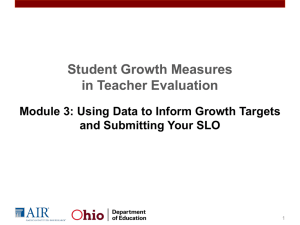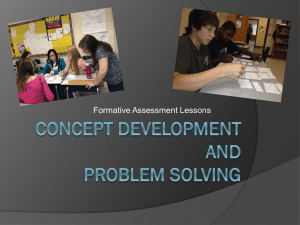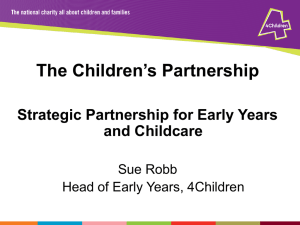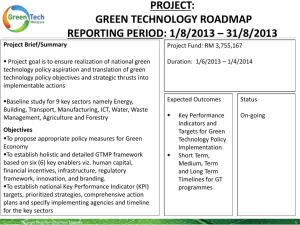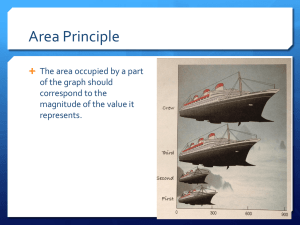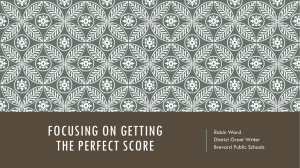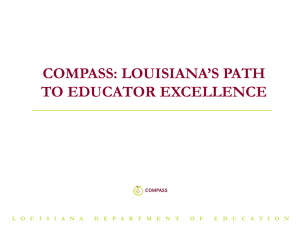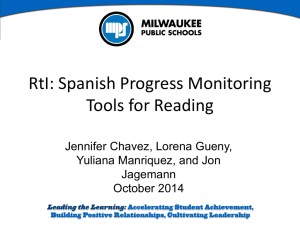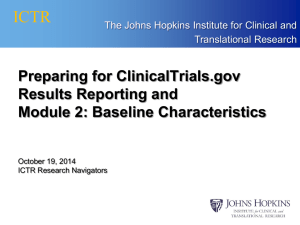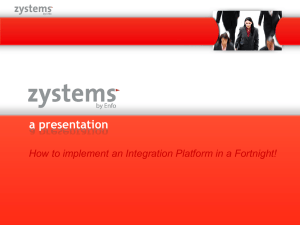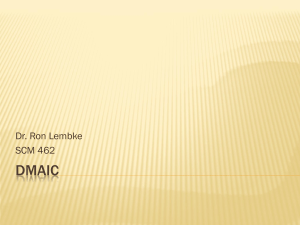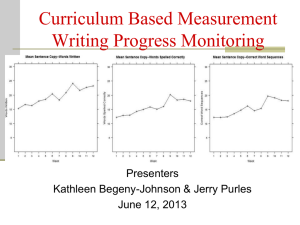APS Teacher Evaluation
advertisement
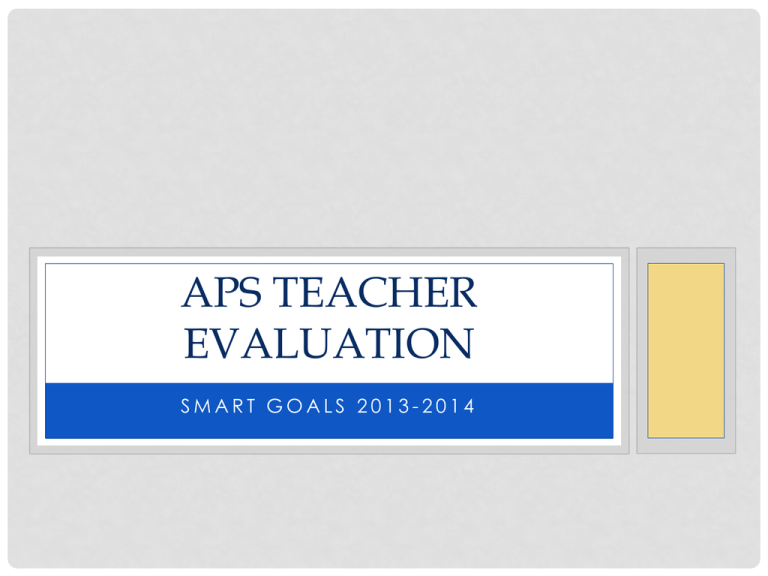
APS TEACHER EVALUATION SMART GOALS 2013-2014 AGENDA • Purpose • Balancing Realism and Rigor • Progress Based Goals • Three Types of Goals • Avoiding Averages • Goal Critique PURPOSE PURPOSE OF STUDENT PROGRESS GOAL SETTING • Focuses on student results • Explicitly connects teaching and learning • Improves instructional practices and teacher performance • Serves as tool for school improvement WHAT IS STUDENT PROGRESS GOAL SETTING? Step 2: Step 1: Determine needs Create specific learning goals based on preassessment Step 3: Create and implement teaching and learning strategies Step 4: Monitor student progress through ongoing formative assessment Step 5: Determine whether the students achieved the goal BALANCING REALISM AND RIGOR SMART GOALS Specific Measureable Appropriate Realistic, but Rigorous Time limited BALANCING REALISM AND RIGOR • Consider cut scores from Virginia Department of Education (or from other assessments) • 22 out of 40 items = pass/proficient • 34 our of 40 items = pass/advanced • Consider Curriculum • What are the needs of the curriculum (e.g. spiral curriculum)? • Have students been exposed to the information before? • Consider historical data PROGRESS BASED GOALS WHY PROGRESS BASED GOALS? 100% 90% 80% 70% 60% 50% End of Year 40% Beginning of Year 30% 20% 10% 0% Teacher A Teacher B PROGRESS VS. ACHIEVEMENT Progress Based Goal Achievement Based Goal • For the 2013-2014 school year, the identified students will increase their score by a minimum of 2 points on the writing rubric. OR • For the 2013-2014 school year, students will score X% greater on the posttest than on the pre-test. • For the 2013-2014 school year, 90% of students will score 80% or better on the third quarter assessment. THREE TYPES OF GOALS THREE TYPES OF GOALS • Whole Group Goals • Tiered Goals • Individual Goals WHOLE GROUP GOALS • The pre-assessment used to determine baseline data reports results in percentages or provides levels of performance. • Data suggest that students come with relatively similar readiness levels for the content being taught. • For outliers (exceptionally low or exceptionally high performing students), individual goals may be developed. WHOLE GROUP EXAMPLE Number of students scoring at each range 9 8 7 6 5 4 3 2 1 0 8 8 4 Number of students scoring at each range During the course of this school year, 100 percent of students will make measureable progress as measured by the divisiondeveloped assessment. All students will improve their pre-assessment score by 65 percentage points on the post assessment. TIERED GOALS • The pre-assessment used to determine baseline data reports results in percentages or provides levels of performance. • Data suggest that students come with very different readiness levels for the content being taught. • For outliers (exceptionally low or exceptionally high performing students), individual goals may be developed. TIERED EXAMPLE Number of students scoring at each level 10 9 8 7 6 5 4 3 2 1 0 9 6 5 0-30% Number of students scoring at each level 31-50% 51-70% TIERED EXAMPLE • During the course of this school year, 100 percent of students will make measureable progress as determined by the team-developed assessment. Students will improve their scores as follows: • Students scoring between 0 and 30 percent on the preassessment will improve their scores by 40 percentage points on the post-assessment. • Students scoring between 31 and 50 percent on the preassessment will improve their scores by 35 percentage points on the post-assessment. • Students scoring between 51 and 70 percent on the preassessment will improve their scores by 30 percentage points on the post-assessment. INDIVIDUAL GOALS • The pre-assessment used to determine baseline data reports results in percentages or provides levels of performance. • Used for smaller groups of students with a variety of readiness level and background knowledge. • Acceptable amounts of progress are often dependent on students’ historical academic performances. INDIVIDUAL EXAMPLE For the 2013-2014 school year, all my students will make measurable progress as measured by the online reading assessment. Based on their IEPs, their goals are as follows: Student Grade Current Level Goal Level 1 K Pre-K.1 K.6 2 K Pre-K.2 1.0 3 1 Pre-K.5 K.5 4 2 K.2 1.7 5 2 K.4 2.0 6 3 1.3 2.8 AVOIDING AVERAGES AVOIDING AVERAGES • Avoid using class averages when writing your SMART goal. • Can hide variability • Some students make actually score lower and the average may still be higher • Averages don’t allow you to track the progress of individual students and adjust instruction to help lagging students meet the goal you have set for them. CRITIQUING GOALS GRADE 7 ENGLISH TEACHER Q • Grade 7: Baseline Reading Data • Online reading assessment used • Beginning of the year reading levels • 6.7 and below = below grade level • 6.8-7.2 = on grade level • 7.3 and above = above grade level TEACHER Q STUDENT READING BASELINE DATA Student Baseline Score Student Baseline Score Student 1 5.3 Student 11 6.8 Student 2 5.5 Student 12 6.8 Student 3 5.5 Student 13 6.8 Student 4 5.5 Student 14 7.0 Student 5 5.6 Student 15 7.2 Student 6 5.7 Student 16 7.4 Student 7 6.2 Student 17 7.6 Student 8 6.3 Student 18 7.7 Student 9 6.6 Student 19 7.7 Student 10 6.6 Student 20 8.0 STUDENT BASELINE READING DATA: TIERS Number of Students 12 10 10 8 6 5 5 On Grade Level Above Grade Level 4 2 0 Below Grade Level Number of Students TEACHER Q EVALUATE: IS THIS GOAL SMART? Goal Statement: From September 2013, to June 2013, 100 percent of students will make measurable progress in reading as measured by the online assessment. All students will improve their baseline score by 1.0 grade levels by the post assessment. A good goal statement is one that is… Specific Measurable Appropriate Realistic, but Rigorous Time-limited AGENDA • Purpose • Balancing Realism and Rigor • Progress Based Goals • Three Types of Goals • Goal Critique APS TEACHER EVALUATION SMART GOALS 2013-2014


